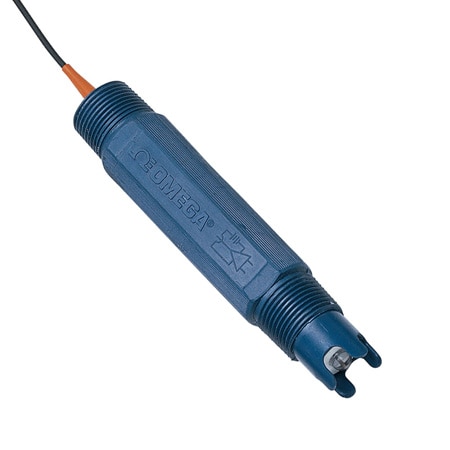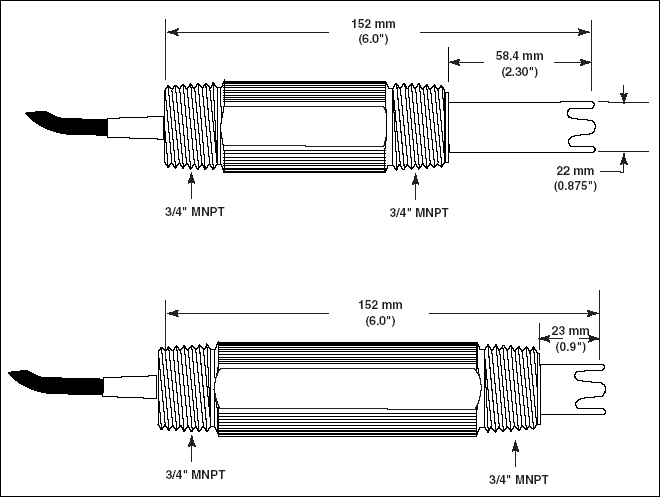Bienvenue sur notre nouveau site Web, vous avez rencontré un problème ou un bug? Veuillez le signaler ici

7352-3-Series
Heavy-Duty Combination pH Sensor For Submersible Applications
- Strong PPS Body
- Low Maintenance
- Short or Long Insertion Lengths
- Any Angle Orientation
7352-3-Series
Depuis
C$
304.12
L'aperçu du produit
- Applications Agricultural & Hydroponics Applications, Chemicals, Environmental Monitoring, Food and Beverage, Mining & Metallurgy, Pharmaceuticals, Power Plants & Boilers, Pulp & Paper Industry, Water Treatment
- Cable Length 4.6 m
- Diameter 0 mm
- Drift <2 mV per week
- Electrical Connection N/A
- Enclosure Material PPS, PTFE, FKM, Glass
- Impedance 150 MΩ
- Length 0 mm
- Measurement Type pH
- PH Measurement Range 0 to 14 pH
- Pressure, Max 100 psig
- Pressure, Min 0 psig
- Pressure Note 0 to 100 psig or 0 to 150 psig (HT high temperature version) β ±0.1% over full range
- Process Connection Size 3/4 in
- Process Connection Type NPT Male
- Process Temperature, Max 80 °C
- Process Temperature, Min 0 °C
- Reference Cell Double junction, KCl/AgCl, KNO3
- Response Time 95% of reading in 10 sec
- Sensor Type N/A
- Sodium Error Less than 0.05 pH in 0.1 Molar Na+ ion @ 12.8 pH
- Temperature Note 0 to 80°C (32 to 176°F) or 0 to 110°C (32 to 230°F) (HT high temperature version)
- Zero/Balance Error 7.0 ±0.2 pH
The PHE-7352-15 is a combination pH sensor designed for insertable use in process and waste water applications where greater pipeline penetration is required. The outer body material is PPS and has ¾ MNPT front and rear facing threads with 57.1 mm (2¼") insertion depth. The sensor features sealed double junction construction which is highly resistant to electrode poisoning solutions, (typically those with cyanide, ammonia, sulfide and heavy metals in appreciable concentrations). The use of the non-fouling patented Porous PTFE liquid junction ensures a steady presence of reference electrolyte. Coupled with the novel Plunger pH glass electrode design, this sensor assures a low long maintenance service life in most applications. Use of the high temperature version is recommended where service temperatures continuously exceed 80°C (176°F).
Application
• Suitable for Severe Conditions
• Large Diameter Pipe Insertion
• Waste Water Pipeline Insertion

Application
• Suitable for Severe Conditions
• Large Diameter Pipe Insertion
• Waste Water Pipeline Insertion

PDF et manuels
Afficher les notes et les avis
Rated 5 out of
5
by
kram9999 from
Works well.
Built in temperature sensor is nice.
Much cleaner design than older model.
Interested to see how long this sensor lasts in our steel pretreatment.
Date published: 2018-01-25
Rated 1 out of
5
by
bentmol from
Missing information
The new Omega website sucks. It has less information than the old one did. For example, the data sheet for this pH sensor does not say that it needs a power supply and another component to make this sensor work. I know this because we had to buy all 3.
Date published: 2019-09-13
Item PHE-7352-15 pH probe; can I land cable to terminal strip and extend another 150 feet to controller PHCN-961 without amplifier? If so what cable do you recommend?
Thank you for your inquiry. The maximum cable distance we recommend without an amplifier is 50ft.
Date published: 2020-03-11
I need to monitor the pH through the building automation system. Can this sensor produce a 4-20ma or 0-10vdc signal?
No. This probe cannot produce a 4-20 mA or 0-10 VDC process signal.
Review pH probe PHETX-600 instead.
Date published: 2020-02-13
can this unit be used to just act as a water detector? and if you sell a better sensor for this application im asking with the same install profile as this, what is the model?
Thank you for your inquiry. Unfortunately, it is a pH probe to measure only pH of a liquid, not as a detector and no longer carry such a product.
Date published: 2023-04-05
Can this sensor be fully submersed, free floating in a reservoir? (e.g., entire sensor and a few feet of the cable)
Thank you for your inquiry about the pH probe. It can be submersed in a reservoir, yet, the cable is only potted, not water sealed. Using shrink wrap or snake into a pipe to protect water from getting into the body.
Date published: 2022-09-07
How do the leads connect to a display/controller (BNC)?
Hello! Thanks for your question. This pH electrode has a female BNC connector that attaches to the male BCN connector on the controller. If the controller has a terminal connector instead of the BNC then you need an adapter part # ADAPTOR-BNCF-SL.
Date published: 2020-04-30
What material is the seal between the electrode and the sensor body made of?
Thank you for your inquiry about the pH probe. The sensor body is made of PPS (or Ryton) and has a PTFE and FKM seal within the electrode tip.
Date published: 2021-10-21
Is this pH sensor a combination sensor (outputs pH and temperature)? Or does a temperature sensor need to be purchased in addition to this sensor?
Thank you for your inquiry. The pH probe when connected to a pH display or controller will display the pH and compensate for temperature, not display. Unless, your current display or controller has that option, then, it will display temperature as well.
Date published: 2022-09-07
Is there an upper limit on the turbidity (NTU) that will effect the accuracy of this probe? I would like to use this in a very turbid and particle rich environment.
Thank you for your inquiry. Unfortunaetly, there is no data for a maximum NTU levels, since there is a protective guard, it should keep out the debris. Please note that ideally, it should be free of suspended particles that can adhere onto the glass bulb and you will need to incorporate in SOP (Standard Operating Procedure) to clean the glass bulb if covered by debris.
Date published: 2024-08-12